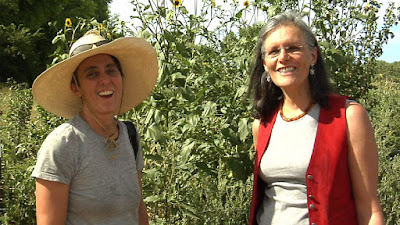Catherine Harris and I at the Fodder Project
In 2000, Bill Gilbert started the Landarts Program at University of New Mexico. The students explore human interventions on the land from prehistoric to the present. Their most recent focus is sustainability in the southwest especially relating to food production and water use. These are issues that have shaped this land historically. Drought and famine and possibly disease are thought by some to have caused New Mexico's magnificent Chaco Canyon and the very advanced society that either lived at or used that site, with its ruins of an extensive compound of buildings, to have been extinguished. It is a place of historical mystery that can be palpably felt when you visit.
Here is a link to read more about this innovative program. Students can now receive an MFA in Art and Ecology. This quote from the site gives you a sense of the diversity of places they visit.
Each year the Land Arts program travels extensively throughout the southwestern United States and north central Mexico to live and work for over fifty days on the land. Our time is divided between investigating cultural sites such as Chaco Canyon, Roden Crater, Hoover Dam, Wendover Complex of the Center for Land Use Interpretation, Juan Mata Ortiz, Spiral Jetty and the Very Large Array and working in the variety of eco-niches provided by our campsites at places such as the Grand Canyon, Grand Gulch, Gila Wilderness, Bosque del Apache and Otero Mesa Grasslands. Our current focus is on the issues of sustainability with a particular interest in food production and water use in the southwest.
The students are presently on one of their trips across the southwest if you would like to
follow their journeys on their blog.
Here is another blog link that follows the students adventures in Australia this past summer.
That is a trip I would have loved to have been on. They have such a different perspective and itinerary than the average traveler.
The Art and Ecology students husk a variety of types of corn to make their own homemade corn bread.
We met up with a group of Landarts students, instructors Catherine Harris and Jeanette Hart-Mann at the Fodder Project Collaborative Farm last year, to shoot some footage for our grant proposal to the New Mexico Arts Council, which we will be presenting this January. We always try to feature at least one innovative educational program that emphasizes art and ecology in each of our Creative-Native Project documentaries. The students were learning about growing and creating their own food at the farm that Jeanette Hart-Mann, her husband and two children live on. Jeanette and her family are very involved with permaculture, sustainability and education and are living the experience on their farm in Anton Chico.
Jeanette in their garden
Catherine Harris in the bountiful organic garden
Permaculture is an approach to designing human settlements and agricultural systems that are modeled on the relationships found in naturalecologies. The word 'permaculture' was coined by Bill Mollison and David Holmgren as a contraction of permanent (sustainable) and agriculture.
Permaculture is sustainable land use design. This is based on ecological and biological principles, often using patterns that occur in nature to maximise effect while minimizing wasted energy. Permaculture aims to create stable, productive systems that provide for human needs, harmoniously integrating the land with its inhabitants. The ecological processes of plants, animals, their nutrient cycles, climatic factors and weather cycles are all part of the picture. Inhabitants’ needs are provided for using proven technologies for food, energy, shelter and infrastructure. Elements in a system are viewed in relationship to other elements, where the outputs of one element become the inputs of another. Within a Permaculture system, work is minimised, "wastes" become resources, productivity and yields increase, and environments are restored. Permaculture principles can be applied to any environment, at any scale from dense urban settlements to individual homes, from farms to entire regions.
Permaculture as a systematic method was developed by Australians Bill Mollison and David Holmgren and their associates during the 1970s in a series of publications.
The intent is that, by training individuals in a core set of design principles, those individuals can design their own environments and build increasingly self-sufficient human settlements: ones that reduce society's reliance on industrial systems of production and distribution that Mollison identified as fundamentally and systematically destroying Earth's ecosystems.
While originating as an agroecological design theory, permaculture has developed a large international following. This "permaculture community" continues to expand on the original ideas, integrating a range of ideas of alternative culture, through a network of publications, permaculture gardens, intentional communities, training programs, and internet forums. In this way, permaculture has become a form of architecture of nature and ecology as well as an informal institution of alternative social ideals.




No comments:
Post a Comment